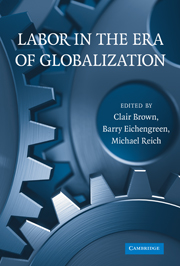Book contents
- Frontmatter
- Contents
- Tables and Figures
- List of Authors and Editors
- Introduction: Labor in the Era of Globalization
- PART ONE POLITICAL ECONOMY AND LABOR MARKET INSTITUTIONS
- 1 Institutions and Wages in Post–World War II America
- 2 American Exceptionalism and Comparative Political Economy
- 3 Finance and Labor: Perspectives on Risk, Inequality, and Democracy
- PART TWO INSTITUTIONS AND FIRM AND WORKER BEHAVIOR
- PART THREE CONTEMPORARY LABOR–MANAGEMENT RELATIONS
- PART FOUR PUBLIC POLICY AND U.S. LABOR-MARKET STRUCTURE
- Index
- References
3 - Finance and Labor: Perspectives on Risk, Inequality, and Democracy
Published online by Cambridge University Press: 05 June 2012
- Frontmatter
- Contents
- Tables and Figures
- List of Authors and Editors
- Introduction: Labor in the Era of Globalization
- PART ONE POLITICAL ECONOMY AND LABOR MARKET INSTITUTIONS
- 1 Institutions and Wages in Post–World War II America
- 2 American Exceptionalism and Comparative Political Economy
- 3 Finance and Labor: Perspectives on Risk, Inequality, and Democracy
- PART TWO INSTITUTIONS AND FIRM AND WORKER BEHAVIOR
- PART THREE CONTEMPORARY LABOR–MANAGEMENT RELATIONS
- PART FOUR PUBLIC POLICY AND U.S. LABOR-MARKET STRUCTURE
- Index
- References
Summary
We live in an era of financialization. Since 1980, capital markets have expanded around the world; capital shuttles the globe instantaneously. Shareholder concerns drive executive decision making and compensation, and the fluctuations of stock markets are a source of public anxiety. So are the financial scandals that have regularly occurred in recent years: junk bonds in the 1980s, lax accounting and stock manipulation in the early 2000s, and debt securitization today.
We also live in an era of rising income inequality and employment risk. The gaps between top and bottom incomes and between top and middle incomes have widened since 1980. Greater risk takes various forms, such as wage and employment volatility and the shift of responsibility from employers to employees for pensions and, in the United States, health insurance.
There is an enormous literature on financial development and another on inequality; however, relatively few studies consider the intersection of these phenomena. Standard explanations for rising inequality – that is, skill-biased technological change and trade – account for only 30 percent of the variation in aggregate inequality. What else matters? We argue here that an omitted factor is financial development. This chapter explores the relationship between financial markets and labor markets along three dimensions: contemporary, historical, and comparative. For the world's industrialized nations, we find that financial development waxes and wanes in line with top income shares.
- Type
- Chapter
- Information
- Labor in the Era of Globalization , pp. 94 - 150Publisher: Cambridge University PressPrint publication year: 2009
References
- 1
- Cited by



